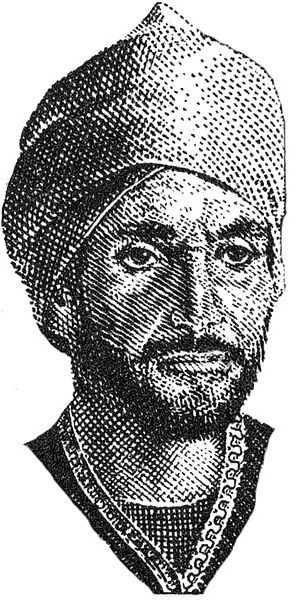Abu Tammam facts for kids
Quick facts for kids
Ḥabīb ibn Aws al-Ṭā’ī
|
|
|---|---|
 |
|
| Native name |
حبيب بن أوس الطائي
|
| Born | ca. 796/807 AD Jasim |
| Died | 845 AD Mosul |
| Pen name | Abū Tammām |
| Language | Arabic |
| Period | Islamic Golden Age (Abbasid era) |
Ḥabīb ibn Aws al-Ṭā’ī (حبيب بن أوس الطائي), better known as Abū Tammām (أبو تمام), was a very important Arab poet. He lived during the 9th century, a time known as the Islamic Golden Age. He was born around 796 or 807 AD and died in 845 AD. Abū Tammām is most famous for putting together a huge collection of early poems called the Hamasah. This collection is considered one of the greatest books of Arabic poetry ever created.
Contents
Abū Tammām's Early Life and Journey
Abū Tammām was born in a small town called Jasim in Syria, near Damascus. His father was a Christian named Thādhūs. It is believed that Abū Tammām later became a Muslim. He changed his father's name to Aws and connected his family to an old Arab tribe called T̩ayy.
Becoming a Poet
Abū Tammām spent his younger years in Homs. Some stories say he worked selling water at a mosque in Cairo when he was a boy. He started his career as a poet in Egypt. However, he couldn't earn enough money there. So, he moved to Damascus and then to Mosul.
He tried to get support from the caliph al-Ma'mun of the Abbasid Caliphate, who ruled a large empire. But Abū Tammām didn't impress him at first.
Finding Patrons and Fame
Abū Tammām then traveled to the eastern parts of the caliphate. He started to gain fans and important people who supported him. He wrote poems praising officials, like the governor of Arminiya, Khalid ibn Yazid al-Shaybani. This governor reportedly gave him a lot of money for his poems and helped pay for his travels.
After al-Ma'mun died, a new caliph named al-Mu'tasim came to power. Abū Tammām, who was now famous, met the new caliph. Al-Mu'tasim quickly took him under his wing. After 833 AD, Abū Tammām mostly lived in Baghdad, at the caliph's court. He also visited Khorasan from Baghdad, where he was favored by Abdullah ibn Tahir al-Khurasani. Abū Tammām died in Mosul in 845 AD.
The Famous Hamasah Collection
Abū Tammām is best known for his amazing collection of poems called the Hamasah. The word Hamasah (Arabic: حماسة) means "exhortation" or "encouragement." It is one of the most important collections of Arabic literature ever put together.
How the Hamasah Was Created
Abū Tammām gathered these poems when he was stuck in Hamadan because of heavy snow. While there, he had access to an excellent library. The Hamasah contains ten books of poems. All the poems are grouped by their subject. Some of them are parts of longer poems. This collection is a treasure of early Arabic poetry, and the poems are known for their great beauty.
Later, another poet named al-Buhturi also made a collection with the same name. Today, the word "Hamasah" can also mean "heroic epic" in modern times.
Abū Tammām's Poetry Style
The famous poet al-Buhturi was a student of Abū Tammām. Both poets belonged to the Tay' tribe. In Arabic literature, people often compare Abū Tammām and al-Buhturi.
Comparing Poetry Styles
Abū Tammām is usually seen as a poet who wrote in an "artificial" (masnû') style. This means his poems were carefully crafted and sometimes used complex language. On the other hand, his student al-Buhturi is often seen as representing a "natural" (matbû‘) poetry style, which was more flowing and simple.
Abū Tammām's own poems were very popular during his lifetime. They were known for their clear style and how well they handled different topics. His poems often described historical events and people. They were also connected to the ideas of the Abbasid period. His poems were published in Cairo in 1875.
See also
 In Spanish: Abu Tammam para niños
In Spanish: Abu Tammam para niños

